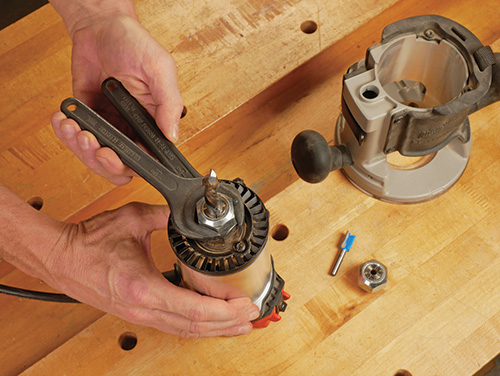
Thank you for the info about ‘Tightening a Loose Chuck’. I have a problem with getting a router bit out of a tightened chuck I have tried everything I can think of.
Michael Dresdner: If you set the bit correctly, so that there is a small amount of space at the bottom, you can often free it after loosening the retaining ring, by tapping the top with a wooden mallet.
Of course, if the bit is seated so that its shaft is resting on the bottom of the collet recess, this won’t work. In that case, you have two other choices.
Remove the ring and collet entirely from the router by threading it completely off. On some routers, the collet is separate from the ring; on others it is not. Once the collet-and-bit are removed from the router, you can hold it in a wood jaw vise clamped to the flats on the retaining ring, and tap the bottom of the router bit shaft with a flat end drift pin to dislodge it. Or, with the ring in the vise, grab the bit with a set of plastic jaw pliers, and twist it until it cracks free.
Once the bit is free, look carefully at both the bit shaft and the inside of the collet to find out why they stuck. The metal should be clean and free of resin, and there should be no rough spots or dings on either the bit shaft or collet. Both surfaces should be clean and smooth.
As tempting as it is to use machine oil, silicone, or WD-40 to loosen the bond, resist the temptation. Once the collet is oiled, it may not hold bits securely, making the tool a safety hazard.
Lee Grindinger: It sounds like it’s time to retire that collet and nut. Collets are made to spring open when the pressure from the nut is released, yours is no longer releasing. Once you replace the collet, here are a couple of pointers for extending its life. Don’t over-tighten. Most of us have had a router bit slip and a natural reaction is to crank that nut on so tight the blood vessels in our foreheads nearly burst. This will dramatically shorten the life of a collet and the nut. If a bit slips when the nut is properly tightened, the collet is not doing its job and needs to be replaced. Also, do not bottom out the bit when you slide it into the collet. Leave an eighth of an inch at the bottom, because as the nut tightens the collet is pulled downward. To properly hold a router bit, the collet moves inward and downward as the nut is tightened. A bottomed bit will prevent this downward movement.






